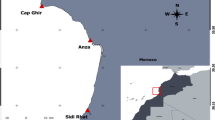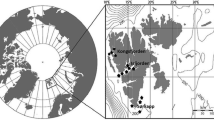Abstract
Octopus insularis inhabits shallow waters along the coast and oceanic islands of northeastern Brazil, where it is the main target of commercial fishing of octopuses. This study aims to investigate the hypothesis that the tropical O. insularis has a distinct gonadal development and reproductive features when compare to its congener O. vulgaris from the subtropical regions. In order to describe its reproductive development, 545 octopuses were collected in the Northeastern Brazil. A good correspondence was observed between the gonad morphology and its histological structure. Oocytes in different development stages were observed in mature females. Most female in early maturity stages had sperm stored in the spermathecae, indicating that females copulate when still immature. There was no correlation between testis weight and the Needham complex, suggesting a protracted period of spermatophore production. Octopus insularis has a general gonadal development pattern similar to O. vulgaris, however, some differences were observed, as maturation at a smaller size, probably associated to a shorter life, and lower fecundity. The distinct reproductive features of O. insularis seem to be related to less variable conditions in the tropical environments. Management should take into account the differences and establish specific rules for the Northeast Brazil octopus fisheries.








Similar content being viewed by others
References
Arkhipkin, A. I., 1992. Reproductive system structure, development and function in cephalopods with a new general scale for maturity stages. Journal of Northwest Atlantic Fishery Science 12: 63–74.
Avila-Poveda, O. H., R. F. Colin-Flores & C. Rosas, 2009. Gonad development during the early life of Octopus maya (Mollusca: Cephalopoda). The Biological Bulletin 216: 94–102.
Barbosa, S. S., S. B. Santos & A. R. G. Tomás, 1997. Análise crítica dos índices de maturidade de Hayashi, Guerra e Moriyasu para uma população de Octopus vulgaris Cuvier, 1797 (Cephalopoda: Octopodidae). Arquivos de Biologia e Tecnologia 40: 279–283.
Batista, B. B., 2011. Estimativa da idade do polvo, Octopus insularis capturado com espinhel de potes no Ceará, relacionada com os estágios de maturação gonadal. Dissertation, Universidade Federal do Ceará, Fortaleza, Brasil.
Bouth, H. F., T. S. Leite, F. D. Lima & J. E. Lins Oliveira, 2011. Atol das Rocas: an oasis for Octopus insularis (Cephalopoda: Octopodidae). Zoologia 28: 45–52.
Boyle, P. & P. G. Rodhouse, 2005. Cephalopods: Ecology and Fisheries. Blackwell Science, Oxford, UK.
Brazilian Fishery and Aquaculture Ministry (Ministério da Pesca e Aquicultura). Instrução Normativa no 15, 19 de junho, 2007. Diário Oficial da União 1: 1–5.
Caparro, L. S., 2010. Report of the Workshop on Sexual Maturity Staging of Cephalopods (WKMSCEPH). ICES, International Council for the Exploration of the Sea, Livorno, Italy.
Carvalho, J. M. N. & C. S. Reis, 2003. Contributions to knowledge on the maturation and fertility of the common octopus Octopus vulgaris Cuvier, 1797 on the Portuguese coast. Boletin del Instituto Español de Oceanografia 19: 473–481.
Froesch, D. & H. J. Marthy, 1975. The structure and function of the oviducal gland in octopods (Cephalopoda). Proceedings of Royal Society B 188: 95–101.
Gonçalves, I., J. Sendão & T. C. Borges, 2002. Octopus vulgaris (Cephalopoda: Octopodidae) gametogenesis: a histological approach to the verification of the macroscopic maturity scales. Abhandlungen Der Geologischen Bundesanstalt 57: 79–88.
Guerra, A., 1975. Determinación de las diferentes fases del desarrollo sexual de Octopus vulgaris Lamarck, mediante un índice de madurez. Investigation Pesquera 39: 397–416.
Gutiérrez, M., 1967. Coloración histológica para ovarios de peces, crustáceos y moluscos. Investigación Pesquera 31: 265–271.
Hanlon, R. T. & J. B. Messenger, 1996. Cephalopod Behavior. Cambridge University Press, London.
Hernández-García, V., J. L. Hernández-López & J. J. Castro-Hdez, 2002. On the reproduction of Octopus vulgaris off the coast of the Canary Islands. Fisheries Research 57: 197–203.
Huffard, C. L., R. L. Caldwell & F. Boneka, 2008. Mating behavior of Abdopus aculeatus (d’Orbigny 1834) (Cephalopoda: Octopodidae) in the wild. Marine Biology 154: 353–362.
Idrissi, F. H., N. Koueta, M. Idhalla, D. Belghyti & S. Bencherifi, 2006. Les modalités du cycle sexuel du poulpe Octopus vulgaris du Sud marocain (Tantan, Boujdour). Comptes Rendus Biologies 329: 902–911.
Jennings, S., M. S. Kaiser & J. D. Reynolds, 2001. Marine Fisheries Ecology. Blackwell Science, Oxford, UK.
Jiménez-Badillo, M. L., R. E. Río-Rodríguez, M. I. Gómez-Solano, A. Cu-Escamilla & D. Méndez-Aguilar, 2008. Madurez gonádica del pulpo Octopus vulgaris en el Golfo de México: Análisis macroscópico y microscópico. Coléccion Expomex@livro. Universidad Autónoma de Campeche: 48 pp.
Leite, T. S., M. Haimovici, W. Molina & K. Warnke, 2008. Morphological and genetic description of Octopus insularis new species (Cephalopoda: Octopodidae), a cryptic species in the Octopus vulgaris complex from the tropical Southwestern Atlantic. Journal of Molluscan Studies 74: 63–74.
Leite, T. S., M. Haimovici, J. Mather & J. E. Lins Oliveira, 2009. Habitat, distribution, and abundance of the commercial octopus (Octopus insularis) in a tropical oceanic island, Brazil: information for management of an artisanal fishery inside a marine protected area. Fisheries Research 98: 85–91.
Mangold, K., 1983. Octopus vulgaris. In Boyle, P. R. (ed.), Cephalopod Life Cycles: I—Species Accounts. Academic Press, London: 334–364.
Mangold, K., 1987. Reproduction. In Boyle, P. R. (ed.), Cephalopod Life Cycles: II—Comparative Reviews. Academic Press, London: 157–200.
Norman, M., 2003. Cephalopods: A World Guide. Conchbooks, Hackenheim.
O’Dor, R. K. & M. J. Wells, 1978. Reproduction versus somatic growth: hormonal control in Octopus vulgaris. Journal of Experimental Biology 77: 15–31.
Olivares-Paz, A., M. Z. Covarrubias, P. P. Reyes & O. Z. Romero, 2001. Estudio histológico de la ovogénesis y maduración ovárica en Octopus mimus (Cephalopoda: Octopodidae) de la II región de Chile. Estudios Oceanológicos 20: 13–22.
Oosthuizen, A. & M. J. Smale, 2003. Population biology of Octopus vulgaris on the temperate south-eastern coast of South Africa. Journal of Marine Biological Association of the UK 83: 535–541.
Otero, J., A. F. González, M. P. Sieiro & A. Guerra, 2007. Reproductive cycle and energy allocation of Octopus vulgaris in Galician waters, NE Atlantic. Fisheries Research 85: 122–129.
Perez, J. A. A. & M. Haimovici, 1991. Sexual maturation and reproductive cycle of Eledone massyae Voss, 1964 (Cephalopoda, Octopodidade) in Southern Brazil. Bulletin of Marine Science 49(1): 270–289.
Pliego-Cárdenas, R. P., 2011. Reproductive aspects of Octopus hubbsorum (Cephalopoda: Octopodidae) from Espíritu Santo Island, southern Gulf of California, Mexico. Ciencias Marinas 37(1): 23–32.
Quetglas, A., F. Alemany, A. Carbonell, P. Merella & P. Sánchez, 1998. Biology and fishery of Octopus vulgaris Cuvier, 1797, caught by trawlers in Mallorca (Balearic Sea, Western Mediterranean). Fisheries Research 36: 237–249.
Quinteiro, J., T. Baibai, L. Oukhattar, A. Soukri, P. Seixas & M. Rey-Méndez, 2011. Multiple paternity in the common octopus Octopus vulgaris Cuvier, 1797, as revealed by microsatellite DNA analysis. Molluscan Research 31: 15–20.
Rocha, F., A. Guerra & A. F. Gonzaléz, 2001. A review of reproductive strategies in cephalopods. Biological Reviews 76: 291–304.
Rodríguez-Rúa, A., I. Pozuelo, M. A. Prado, M. J. Gómez & M. Bruzón, 2005. The gametogenic cycle of Octopus vulgaris (Mollusca: Cephalopoda) as observed on the Atlantic coast of Andalusia (South of Spain). Marine Biology 147: 927–933.
Rosa, R., L. Gonzalez, H. Dierssen & B. Seibel, 2012. Environmental determinants of latitudinal size-trends in cephalopods. Marine Ecology Progress Series 464: 153–165.
Sauer, W. H. & M. R. Lipinski, 1990. Histological validation of morphological stages of sexual maturity in chokker squid Loligo vulgaris reynaudii D’Orb (Cephalopoda: Loliginidae). South African Journal of Marine Science 9: 189–200.
Silva, L., I. Sobrino & F. Ramos, 2002. Reproductive biology of the common octopus, Octopus vulgaris Cuvier, 1797 (Cephalopoda: Octopodidae) in the Gulf of Cádiz (SW Spain). Bulletin of Marine Science 71: 837–850.
Villanueva, R. & M. D. Norman, 2008. Biology of the planktonic stages of benthic octopuses. Oceanography and Marine Biology: An Annual Review 46: 105–202.
Wells, M. J. & J. Wells, 1956. The function of the brain of Octopus in tactile discrimination. Journal of Experimental Biology 34: 131–142.
Acknowledgments
We are extremely thankful to the small scale fishermen from Rio do Fogo for their willingness to provide information on the fishery and specimens and to Jaciana Barbosa and Lorena Candice, for their collaboration in sampling. The Federal University of the Rio Grande do Norte, the Brazilian Institute of Environment and Renewable Natural Resources (IBAMA), and the Brazilian National Research Council (CNPq 559863/2008-0) are acknowledged for their logistic and financial support.
Author information
Authors and Affiliations
Corresponding author
Additional information
Guest editors: Erica A. G. Vidal, Mike Vecchione & Sigurd von Boletzky / Cephalopod Life History, Ecology and Evolution
Rights and permissions
About this article
Cite this article
de Lima, F.D., Leite, T.S., Haimovici, M. et al. Gonadal development and reproductive strategies of the tropical octopus (Octopus insularis) in northeast Brazil. Hydrobiologia 725, 7–21 (2014). https://doi.org/10.1007/s10750-013-1718-z
Received:
Accepted:
Published:
Issue Date:
DOI: https://doi.org/10.1007/s10750-013-1718-z




